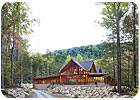
Serving as a model for future National Park Service sites, the Twin Creeks Science and Education Center - located in the Great Smoky Mountains National Park of Tennessee - was built with sustainability in mind, and it is on target to become one of the National Park Service’s first LEED-certified buildings in the southeastern U.S. To adhere to the sustainable objectives of the project, regional river stone was applied as a battered wainscot around the exterior of the structure to help it harmonize with its mountainous surroundings, which also aided in taking advantage of the natural resources around the site.
“The program for this building is to do research,” said Project Manager Meg Needle, AIA, LEED AP, who works for the Atlanta, GA, office of Lord, Aeck & Sargent. “The Great Smoky Mountains National Park is a very bio-diverse, unique part of the world. Congruent with the goals of preserving its assets and understanding the natural habitat of its space, we wanted the building itself to also speak to those goals.”
Part of making sure the design for the building was corresponding with the program’s objective, was to have proper site selection. “The siting was worked around Native American and ancient archaeological sites, so there were many people helping to decide on the site,” Needle said. “When we designed the building, we wanted to make it the aesthetic of the region.”
Needle continued to explain that the particular area is composed of large and small boulders that have been filled in with organics from the forest over the years. “We had to over excavate and use a reinforced stone bed as a foundation over the sub-grade boulders in order to build on the site,” she said, adding that the stone stabilized the soft soil and boulders.
In addition to stone providing a foundation for the structure, the building itself makes use of regional river stone, as it was used for a 4-foot-high wainscot border that runs the perimeter of the exterior.
The architect explained that the use of a flatter stone was considered for practical reasons, as the rounded river stone often requires up to an inch of mortar due to the shape of the individual stones, which makes the installation process longer. However, the architects ultimately felt that the use of river stone selection was right for the aesthetic of the building. “We always wanted to use native, regional material,” said Needle.
Concrete had also been considered for the site retaining walls, but when the boulders were excavated for the foundation, the design team was able to utilize them for slope stabilization to keep the project more natural.
The innate construction of the project has been well received by the park and the public. “The Park Service is very proud of it, as it will be their first - or one of their first - LEED projects in the southeast region,” said Needle. “Overall, I think the city of Gatlinburg and all of the locals are enamored with it - for what the park can offer through their research, for humanity and understanding of the unique ecosystems of the Smoky Mountains.”
Twin Creeks Science and Education Center began design plans in 2001, but with time dedicated to site selection, archeological clearances and securing funds, the 15,000-square-foot building was finally completed in 2007. “It is a small building, but a labor of love,” Needle concluded.